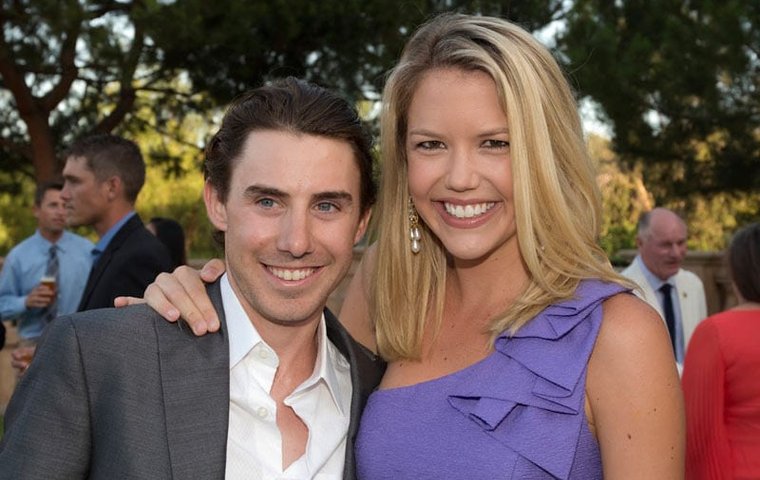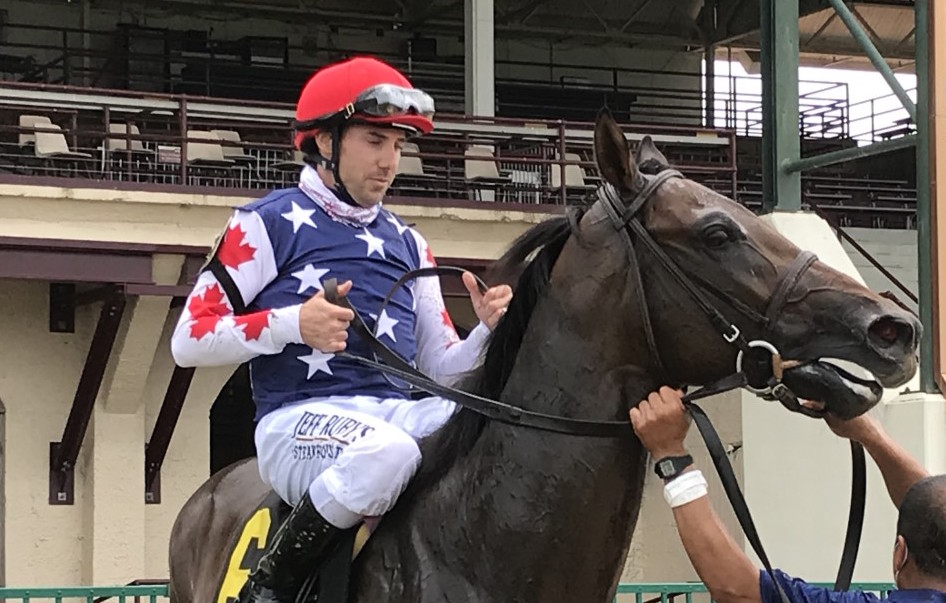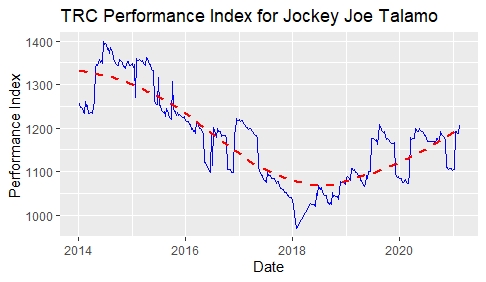
In Henderson, Kentucky, on a balmy August Friday, it is 90 degrees Fahrenheit with humidity making it feel like 100. Cirrus clouds suspend in gigantic and beautiful billows above Ellis Park Racetrack, maintaining a temporary hold on sheets of rain that most assuredly will fall to drench the countryside. In fact, lightning will soon suspend racing for the day after the fourth race.
It is both a far distance and a far cry from Del Mar, near San Diego in California, where an average high temperature in August is 77 and breezes from the Pacific Ocean within sight of the racetrack counter humidity.
The differences are aplenty, in addition to weather. How each is known may say it all: Ellis Park is the ‘Pea Patch’ with soybeans growing in the track’s infield; Del Mar is “where the turf meets the surf”.
The most important difference, however, erases any obvious advantages of San Diego versus Henderson, Kentucky, for jockey Joe Talamo.

Based in California in 2019, Talamo had 547 mounts. In the Midwest in 2020, his mounts totaled 942, a 72 percent increase in business. The statistic that counts most is in dollars and cents; Talamo had $7,991,054 in purse earnings last year compared to $5,184,324 earnings in 2019. It was his best year since 2014.
“It got to where I was averaging less than 15 mounts a week and sometimes less than ten,” Talamo said of the last of 14 years of riding in California. On three separate days in August at Ellis Park, Talamo rode seven races, and on four other days he rode six each day.
The winter of 2019 was the nadir of California racing. Santa Anita was closed for weeks after a spate of horse fatalities and injuries. Horses and races were already in short supply while the number of jockeys, both stars and talented journeymen, stayed the same if not increased. “It became really difficult to get on really, really good horses. And then it became difficult to ride a lot of races in general,” said Talamo.
“When I first got there, there was racing Wednesday through Sunday, then it went from Thursday through Sunday and now it’s Friday through Sunday.”
Shrinking the number of race mounts even more were days when races didn’t fill with entries, reducing race cards to, at times, only seven races, according to Talamo.
While the Ellis meet in 2020 was also Friday through Sunday, the meet was only two months. “But then you go back to Keeneland and Churchill and it’s four days a week. It’s nine or ten races a day,” said Talamo. Also in the Kentucky schedule, were six days at Kentucky Downs in September, an all-turf track on the Tennessee border, with purses that averaged more than $1.9 million a day, the highest daily purse average in North America in 2020.
Immediate results
The move east provided immediate results for the 31-year old native of Marrero, Louisiana, a New Orleans suburb.
Coming to Oaklawn Park at the end of January last year, Talamo was the second leading rider in his first full meet there, earning $3,362,934. Perhaps more impressive, he won nine stakes races. “I would have been very, very happy with two, maybe three. There’s no way I would have expected that,” he said with humility characteristic for the affable jockey.
Skill, of course, is obvious with Talamo, who is now hovering on the edge of the world top 50 in the TRC Global Rankings, and it has given him a reputation that paved the way for getting mounts at Oaklawn. “When I first got there, Brad Cox gave me really pretty much everything,” he said. Other notable trainer-clients included Ron Moquett and Tom Amoss. “There were times when I could have ridden two, three, or four horses in a given race” - quite a turnaround from stiff competition for one mount in fewer races in California.

Success continued for Talamo after Oaklawn. At last summer’s Ellis Park meet, which concluded at the end of August, he won the leading rider title with 20 wins in 106 starts (a 19 percent win average) and earnings of $746,716. Ironically, he beat out fellow California transplant Rafael Bejarano, whose meet was abbreviated by an injury.
Continuing to Churchill Downs for that track’s July-August meet, Talamo finished in the top ten in purse earnings and third in the number of starts.
The number of mounts, however, only tells half the story. Veteran jockey agent Scott McClellan, who has spent over 40 years on California racetracks carrying the ‘book’ of jockeys like Chris McCarron, and who was the agent for Talamo, sums it succinctly: “Purses on the West Coast are not comparable to the East Coast,” he said.
Boosted purses
Boosting purses in the east is off-track betting and/or casinos. In Kentucky, Historical Horse Race machines, which operate much like a slot machine, pump millions into Kentucky purses.
“In California, you’re running for $50,000, $55,000 and a race with the same conditions back east is $80,000. When off-track betting or casino gambling kicks in, it’s going to be $100,000,” said McClellan.
Talamo, as well, is aware of the math. “At Churchill Downs, there are maiden special weight races for $90,000 to $100,000. At Ellis Park in 2019, purses there were $50,000 to $55,000. That was equivalent to Del Mar,” he said, adding with a shake of his head, “That’s pretty amazing.”
Something else not to be overlooked is the cost of living in California versus the East and Midwest. “The cost of living here is half that of California. The math doesn’t lie,” he said.
The relative paucity of trainers in California added to the issues for even a top jockey like Talamo. According to McClellan, Talamo had gotten “all his eggs into one basket”, committing to work horses for Bob Baffert after the break for track maintenance during most mornings at Santa Anita or Del Mar, when the track was at its best.
“To ride for Baffert, we gave up other people [trainers] we used to ride for after the break,” explained McClellan.
Sacrificed too, of course, were the horses of those trainers that Talamo would have ridden in races. In short, Talamo’s client list of trainers was shortened, not a problem with regular mounts from Baffert, but a problem when the Hall of Fame trainer, with the pick of every top jockey in California and nationally, would ride someone else.
There is competition also in the East, primarily at Keeneland in April and October, when riders like Joel Rosario, Javier Castellano, John Velazquez, the Ortiz brothers, and others descend on the Bluegrass. At Keeneland’s October meet in 2020, Talamo finished a very respectable fifth in the standings.
Tough competition
Oaklawn, however, like Ellis Park, offered less competition for mounts. “He was getting on the cream of the crop there,” said McClellan.
Riding for Cox — not quite a ‘Midwest Baffert’ but certainly making a huge name for himself with horses like Monomoy Girl, winner of 13 of 15 starts, including the 2018 Breeders’ Cup Distaff and five other G1s — also factored into the success. Cox is currently TRC world #7, just one place behind Baffert.
Riding at Kentucky, Arkansas, and Louisiana tracks against jockeys who have spent their whole careers in those states, however, is not a ticket to automatic success. “You might not hear about them on a national basis, but riding with them, there’s some really good riders. I have a lot of respect for guys I ride with here,” Talamo said.
“There are quite a few riders here who would have no problem making it in California. But, at the same time, would those trainers out there ride them? Are they going to get the mounts?” he asked, addressing the same issues that he faced as an established rider.
Local in Louisville
Personally as well as professionally, the transition has gone well for Talamo. His wife, Elizabeth, a California native and daughter of West Coast trainer Ron Ellis, was fully supportive of the move and took charge of finding the family both a home in Louisville and pre-school programs for their sons, Dominic and Vincent.
Easing the transition is family already in the city. “Elizabeth’s mother’s whole side lives in Louisville,” said Talamo. Included are two uncles, Paul McGee, who is a trainer, and Marty McGee, who writes for the Daily Racing Form.
Talamo is also closer to his mother and father in New Orleans with the opportunity to ride at Fair Grounds there in the winter as well as at Oaklawn.
Will others from California follow the jockeys that have come east in the past year? “It wouldn’t surprise me, Talamo said. “I know a few guys thinking about it.”
Talamo was actually part of a quartet, including Rafael Bejarano, Martin Garcia, and Tyler Baze (who has since returned to California in September), who moved their tack in 2020. Even in a year shortened by an injury that sidelined him from October 18 through the end of the year, Garcia had 472 mounts in 2020 compared to 418 in California in 2019. Bejarano rode in 656 races last year compared to 638 in 2019.
“At the end of the day, it’s money — where can you win the most. If you can’t win a lot in California, what’s the point of staying there?” said Talamo.
Indeed.
When questioned whether the Kentucky Derby’s traditional playing of My Old Kentucky Home will now and henceforth have special meaning for him since he now has a Kentucky home, Talamo is almost without words. “It is pretty ‘homey’,” he said with a smile. And one likely to become his own old Kentucky home if horse population and purses continue as they are in the East/Midwest and California.


